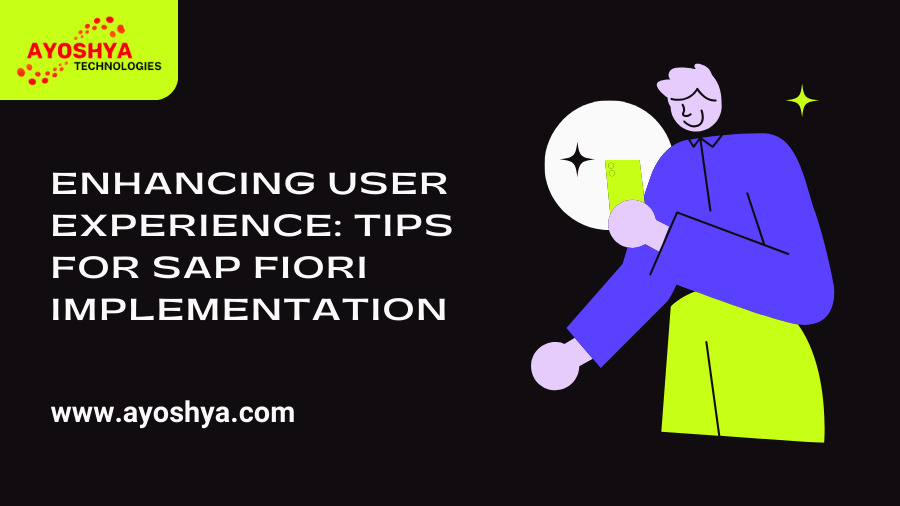Enhancing User Experience: Tips for SAP Fiori Implementation
Introduction to SAP Fiori Implementation
In the ever-evolving landscape of enterprise applications, SAP Fiori has emerged as a game-changer. This article explores the fundamental principles and practical tips for SAP Fiori Implementation to enhance user experience.
SAP Fiori’s design guidelines are built around five core principles:
- Role-based: Fits specific needs and adapts to how a business works
- Adaptive: Adapts to the way a business works
- Simple: Makes SAP screens simpler and more ergonomic
- Coherent: Provides an intelligent, consistent, and integrated user experience
- Delightful: Provides an easier, more intuitive way to run SAP applications
SAP Fiori is used in SAP applications such as:
- S/4HANA and C/4HANA suites
- SAP Analytics Cloud
- SAP Data Hub
- SAP Ariba
SAP Fiori provides over 300 role-based applications, including: HR, Manufacturing, Finance.
SAP Fiori elements is a framework that includes the most commonly used floorplan templates. It’s designed to speed up development by reducing the amount of frontend code needed to build SAP Fiori apps.
Significance of User Experience
Understanding the crucial role user experience plays in the success of any application. We delve into why businesses are increasingly prioritizing user-centric design and how it contributes to overall success.
User experience (UX) is important because it aims to fulfill user needs and provide positive experiences. A good UX can:
- Set a product apart
- Increase customer loyalty and retention
- Build a better customer satisfaction journey
- Attract and retain more customers
- Increase revenue
UX design involves a set of actions and methodologies to understand user needs and goals. This research helps to understand why a product is needed and what would be most valuable to users.
Key Principles of SAP Fiori Design
SAP Fiori is designed using many design principles. The most important ones are that Fiori is role-based, coherent, adaptive, and simple. Utilizing a role-based approach to business applications creates simplicity where you need it most.
Customization for Business Alignment
Recognizing the importance of aligning SAP Fiori with specific business needs. We discuss the customization options available to tailor the user experience according to organizational requirements.
Responsive Design for Multi-Platform Accessibility
In today’s multi-device world, accessibility is paramount. Explore the significance of responsive design in SAP Fiori implementation, ensuring a seamless user experience across various platforms.
Integration with Existing Systems
One of the critical aspects of SAP Fiori implementation is integrating it with existing enterprise systems. We delve into the challenges and strategies for a smooth integration process.
User Training and Adoption Strategies
Even the best-designed systems require user acceptance. Learn about effective training and adoption strategies to ensure a smooth transition and maximize the benefits of SAP Fiori.
Realizing the Benefits: Increased Productivity
Highlighting the tangible benefits businesses can achieve by implementing SAP Fiori. From streamlined processes to increased productivity, discover how SAP Fiori positively impacts organizational efficiency.
Challenges in SAP Fiori Implementation
Acknowledge the common challenges faced during SAP Fiori implementation. Identifying potential roadblocks is the first step in developing effective mitigation strategies.
Overcoming Implementation Challenges
Explore practical solutions and strategies to overcome challenges in SAP Fiori implementation. From technical hurdles to user resistance, discover how businesses can navigate the complexities.
Continuous Improvement and Updates
User expectations evolve, and so should your SAP Fiori implementation. We discuss the importance of continuous improvement and staying updated with the latest features and enhancements.
Measuring User Experience Success
How do you measure the success of SAP Fiori implementation? We explore key metrics and indicators to gauge the impact on user experience and overall business outcomes.
Case Studies: Successful SAP Fiori Implementations
Dive into real-world examples of organizations that have successfully implemented SAP Fiori. Case studies provide insights into best practices and outcomes achieved through effective implementation.
Future Trends in User Experience and SAP Fiori
What does the future hold for user experience and SAP Fiori? Explore emerging trends and technologies that are shaping the future of user-centric design in enterprise applications.
Conclusion
In conclusion, the successful implementation of SAP Fiori is not just a technical endeavor but a strategic move to prioritize user experience. By following these tips and embracing a user-centric approach, businesses can unlock the full potential of SAP Fiori.
FAQs
- Is SAP Fiori suitable for small businesses?
- Yes, SAP Fiori is scalable and can be adapted to the specific needs of small and large businesses alike.
- How long does it take to implement SAP Fiori?
- The duration of implementation varies based on factors such as customization requirements and the complexity of existing systems. A thorough assessment is crucial.
- What training resources are available for SAP Fiori users?
- SAP provides comprehensive training resources, including online courses and documentation, to facilitate user training and adoption.
- Can SAP Fiori be integrated with non-SAP systems?
- Yes, SAP Fiori supports integration with non-SAP systems, allowing businesses to leverage its benefits while maintaining existing infrastructure.
- Are there industry-specific templates available in SAP Fiori?
- SAP Fiori offers industry-specific templates and applications, ensuring relevance and alignment with the unique needs of various sectors.




